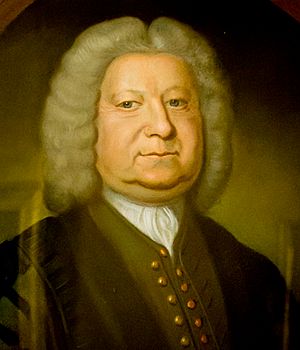Richard Ward (governor) facts for kids
Quick facts for kids
Richard Ward
|
|
|---|---|
 |
|
| 22nd Governor of the Colony of Rhode Island and Providence Plantations | |
| In office 1740–1743 |
|
| Preceded by | John Wanton |
| Succeeded by | William Greene |
| 25th Deputy Governor of the Colony of Rhode Island and Providence Plantations | |
| In office 1740–1740 |
|
| Governor | John Wanton |
| Preceded by | Daniel Abbott |
| Succeeded by | William Greene |
| 29th Attorney General of Rhode Island | |
| In office 1712–1713 |
|
| Governor | Samuel Cranston |
| Preceded by | Simon Smith |
| Succeeded by | John Hammett |
| Personal details | |
| Born | April 15, 1689 Newport, Rhode Island |
| Died | August 21, 1763 (aged 74) Newport, Rhode Island |
| Resting place | Common Burying Ground, Newport |
| Spouse | Mary Tillinghast |
| Occupation | Attorney General, Deputy and Clerk of Assembly, General Recorder, Secretary of State, Deputy Governor, Governor |
| Signature | |
Richard Ward (born April 15, 1689 – died August 21, 1763) was an important leader in the early American colonies. He served as a governor of the Colony of Rhode Island and Providence Plantations. His term as governor lasted from 1741 to 1742.
Contents
Early Life and Family Background
Richard Ward was born in Newport, which is in Rhode Island. His parents were Thomas Ward and Amey Billings. His grandfather, John Ward, came from Gloucester, England. John Ward had been an officer in Cromwell's Army. He moved to the American colonies after King Charles II of England came to power. Richard's father, Thomas, was a merchant who held many positions in the local government.
Ward's Family Life
In 1709, Richard Ward married Mary Tillinghast. She was born in 1689 and passed away in 1767. Mary's parents were John and Elizabeth (Sayles) Tillinghast. Her grandfather, Pardon Tillinghast, came from Seven Cliffs, England. Richard and Mary had 14 children together.
One of their children was Samuel Ward. He later became a governor of Rhode Island, just like his father. Samuel also served as a delegate to the Continental Congress. Two other sons, Thomas and Henry, worked for many years as Secretary of the Colony. Richard Ward's older sister, Mary, married Sion Arnold. Sion was the grandson of Governor Benedict Arnold.
Public Service and Political Career
Richard Ward became a freeman of Newport in 1710. This meant he had the right to vote and hold public office. He then began his career in public service.
Key Roles in Colonial Government
Ward first served as the Attorney General. After that, he became the Deputy and Clerk of the Assembly. From 1714 to 1730, he was the General Recorder for the colony. This role involved keeping official records.
In 1723, he was paid for helping with the trial of some pirates. These pirates were captured by Captain Solgar of the British ship Greyhound. Out of 36 captured pirates, 26 were found guilty. The trial took place in Newport.
Boundary Settlements and Leadership
In 1726, Ward was chosen as one of four commissioners from Rhode Island. Their job was to meet with commissioners from Connecticut. They worked together to decide the official boundary line between the two colonies.
Ward served as the Secretary of State from 1730 to 1733. In 1740, he became the Deputy Governor of the colony. In this role, he and Samuel Perry were appointed as trustees for the Indian sachem Ninigret. In 1741, Richard Ward was elected as the Governor of the colony. He served for one full term.
Later Life and Legacy
Richard Ward sometimes attended the Seventh-day Baptist Church in Newport. This was the church his parents went to. In 1753, when he was 64 years old, he was baptized. He then became a full member of the church.
Richard Ward is buried in the Common Burying Ground in Newport. His son Samuel was first buried in Philadelphia. Later, Samuel's remains were moved and re-interred next to his father.

